Primitive Art – Westernized Presentations of the “Other”
Primitivism is a topic in art history that is often associated with the over-simplified perceptions of the “other” as imposed by artists and art critics from Western and European nations. Such a genre in art existed only due to the lens of colonial forces and the stereotypes that enabled even some of the “best” artists from the past to draw inspiration from various cultures and groups of people considered “primitive”. In this article, we will unpack the history of primitive art by looking at various examples of Primitivism in painting and art history.
A History of Primitivism in Art
The art movement known as Primitivism began with men; the first was a Russian writer known as Vladimir Markov who coined the term in his 1869 book The Man with the Broken Ear about the interpretation of his own work. The next major figure was a French artist named Jean Dubuffet whose marriage of anthropology and art resulted in an approach led by a meeting of worlds between “modern man” and the prehistoric human civilization.
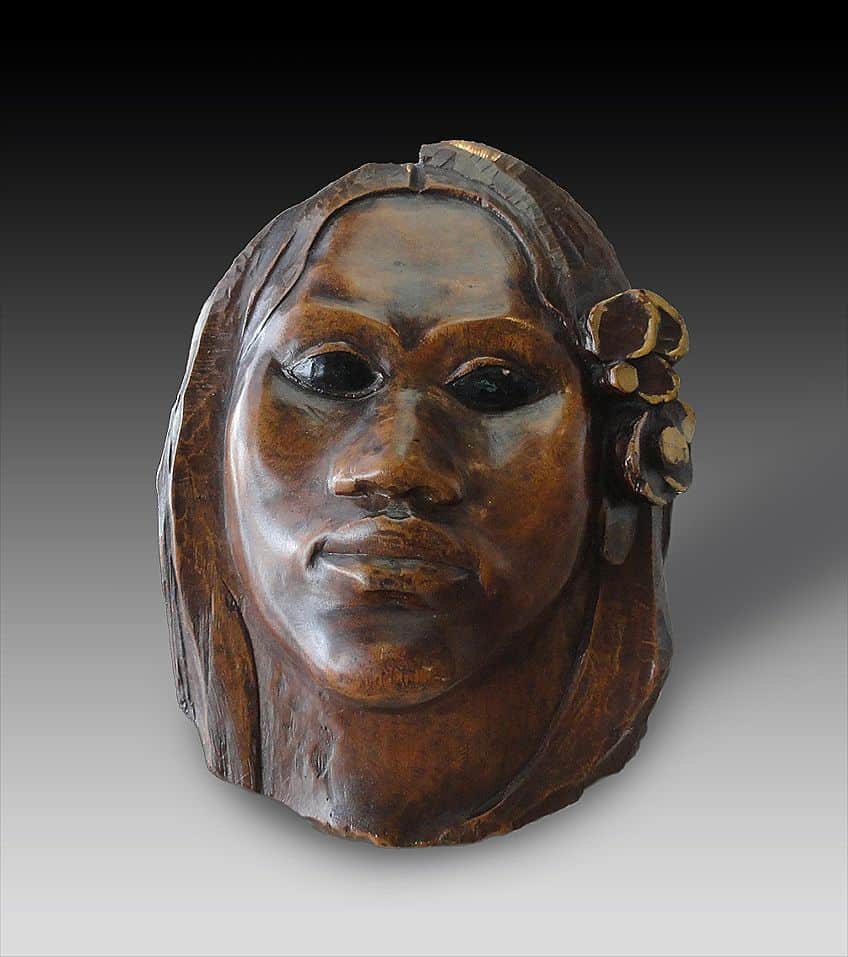
The genre of Primitivism in art emerged, most problematically, as an aesthetic that benefited from the lives, experiences, and value systems of groups of people who were viewed as “exotic”, “oriental”, or “ethnic”. Primitivism in art is a Western concept, intended to highlight the experiences of people perceived as removed from Western civilization. Primitivism was built on borrowed or inspired action by Western European artists in art history who created many well-known artworks, which could easily sell for millions today. The ethics of the genre are questionable, not only in the name and essentialization of indigenous peoples as “primitive” or less advanced cultures but also in the romanticized view of Western European creatives whose admiration of a “removed society” was a form of escapism.
This escapism for Western European creatives was presented as nostalgia, which both captivated and caused chaos in the art world. It is important to understand that the aestheticization of indigenous groups and non-traditional livelihoods of people who were deemed to live an “uncivilized” lifestyle, away from technological developments of the West, were exploited in some way or another.
Traditionally, the term Primitivism refers to methods, styles, and specific motifs in the visual arts that are used to create the “look and feel” of a “primitive” atmosphere.
This is among the many genres in art history, alongside the embedded patriarchal gaze, that is one to be aware of. In this article, we will examine a few artists associated with Primitivism, many of which are highly respected for their artistic contributions, and development of new art styles, and are seen as “revolutionary” figures of art history. We will also take a look at a few examples of Primitive artworks and how such artworks classified under the genre of Primitivism perpetuate racial stereotypes while leveraging elements of art to provide personal modes of escapism.
The Origins of Primitivism
During the Western-European Age of Enlightenment of the 17th and 18th centuries, the reference to indigenous cultures and groups of non-traditional “civilized” people were seen as rhetorical devices, which critics could leverage to make commentary on specific aspects of European society. Before this, the antiquities era in Europe upheld the belief that such “primitive” modes of living, marked by a lack of access to technology and exposure to Western influences, were philosophically superior to the so-called “better” and evolving modern world.
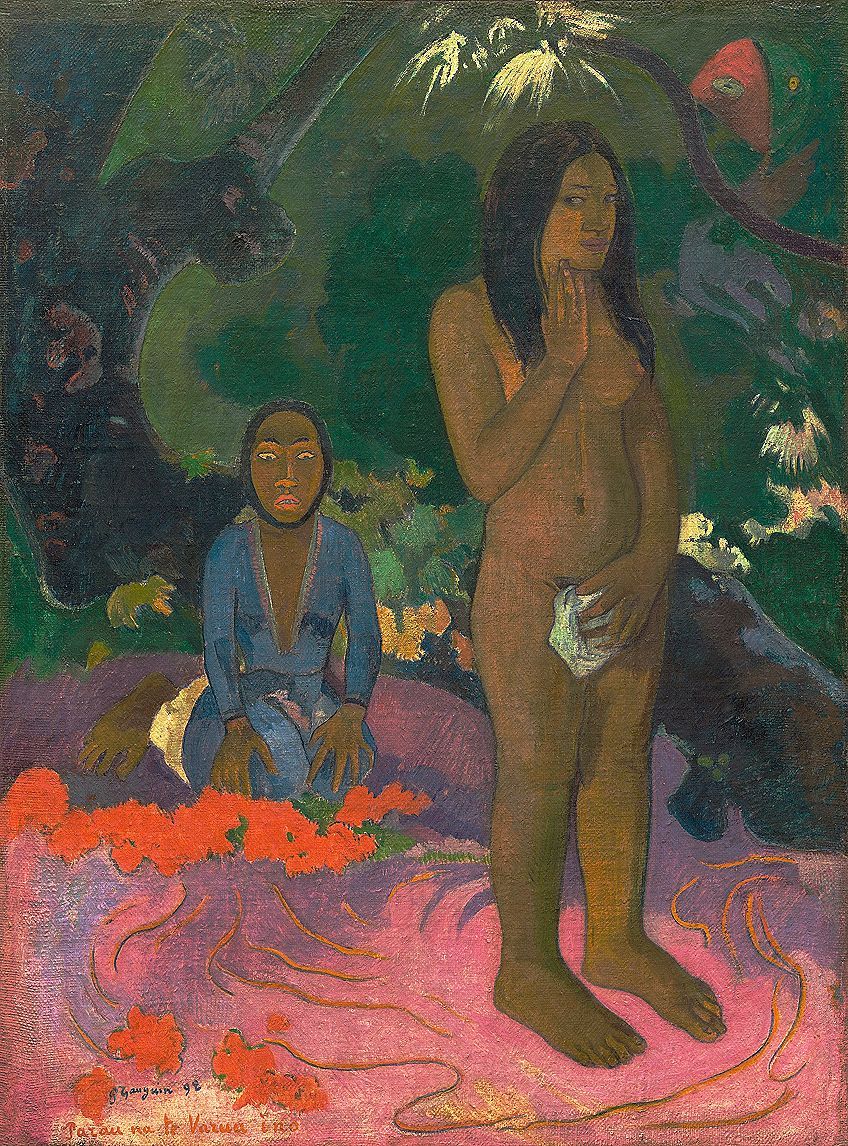
This took place during the Myth of the Golden Age, which is also referenced in European representational art and poetry. The Myth of the Golden Age is a reference to the 8th-century classical Greek poem by Hesiod, which describes the five ages of man. One of these periods is described as the Golden Age, which is the mythological first age of man, founded by the Titan, Cronus, who is also identified as Saturn in Roman mythology.
The poem describes the golden age as a period where mortal men lived like Gods, all of whom did not experience sorrow or toil. Many who died, died in their sleep and no one worked or grew discontent. Even the season of Spring never ended and they existed in an odd time domain where people aged backward. Upon their death, they became demons or in Greek, daemons, who roamed the Earth.
The golden age ceased after Zeus defeated the Titans.
The Primitivism Power Struggle in History
The politics of Primitivism revolve around the so-called approach led by Western-European nations or groups of people who were historically regarded as “civilized”. According to Giambattista Vico, an Italian historian, juror, and philosopher, indigenous and remote societies were viewed as more “modern” than the perceived Western modern man. This opinion was formed during a debate known as the Quarrel of the Ancients and the Moderns. Vico’s argument emphasized the idea of diversity from a broad human point of view, which specified that diversity was necessary for the growth of different perspectives.

This, of course, challenged the consensus of the Age of Enlightenment that human nature was uniform and instead only identified the potential for “primitive” people to develop instead of accepting an alternate perspective on civilization. It is useful to remember that such debates and subjects were emerging from a place of unidentified privilege since the concept of privilege was not a recognized topic in the first place. Thus, it was more conceivable for discussions around the “other” societal groups to occur through a lens of Western European privilege. The 19th century was the birthplace of the official idea of historicism and the “uniformity” that technologically advanced societies imposed on the rest of the world.
This was incredibly impactful on the discipline of the visual arts, which were designed on these foundations and resulted in historicist art movements such as Neoclassicism and the Nazarene movements.
Influential Developments of the 19th Century
A few other developments of the 19th century contributed to the widespread acceptance and interest in the genre of Primitivism. Below, we will unpack some of the key developments of the period that contributed to the rise of Primitivism.

The Photographic Camera
One of the most pivotal innovations that paved the way forward for Primitivism was the development of the camera. The introduction of the photographic camera naturally influenced the fine arts sphere and gave rise to the development of Realism. The camera and the medium of photography also became a tool for documentation, which fascinated many to take up the hobby and incorporate it into their must-haves for travel purposes.
This brings us to the role of photography in supporting the development of Primitivism, which helped many artists and clients of Primitivism artwork to pinpoint a “new” fascination with “undiscovered” cultures, which certain prominent artists in the visual arts helped perpetuate.
Non-Euclidean Geometry
Another important development was the expansion of mathematics, which had the most profound impact when it came to artists realizing that there was more than one way of, quite literally, looking at the world. This newfound birth of added perspective was informed by non-Euclidean geometry, which blew society’s mind. The French Beaux Arts schools of Academic painting had already established a rigid curriculum through which artists would base their worldviews and careers on and the introduction of alternate ways of perceiving reality was what shook the European art sphere. Such academic institutions also promoted the stereotype that “primitive” cultures had no conception of art or what it was, which was later proven wrong by archaeology. Yet, its necessity to be proven was the curse of the intellectual during the Enlightenment.

Transportation and Steamboats
The introduction of steamboats is one of the most underrated innovations in technology that is often overlooked when it comes to understanding the context of art in broader history. The development of an advanced mode of transportation hastened the pursuits of colonial forces who were quick to colonize and conquer other European colonies, including Africa, parts of Asia, the Americas, and the Oceanic Islands. Colonial pursuits involved activities such as the slave trade and the transportation of indigenous people away from their home countries, along with any found goods, artifacts, and “interesting art objects” that colonizers acquired to satisfy personal tastes and increasing demands for more “exciting” subject matter.
The quest for the “elusive ideal” is a notion associated with the quest and necessity to conquer, as enforced by colonial history.
The Appeal of Primitivism Art
Primitivism was inherently flawed in its conception. Many historians would describe the style and preference as a rebellion against the then-current dogmatic approaches to art in the West. Many tend to neglect the effect of cultural rebellions in an art movement context that not only seems to mask the greater issue, but also conceal it. The historical beliefs of Primitivism in art also saw the interpretation of such art through specific visual cues, mark-making patterns, and colors that were associated with Primitive art.

Derogatory remarks would also be made at artists who were untrained and “self-taught”, which further emphasized the reality of Primitivism and its façade of artistic rebellion. The audience to which this genre appealed was primarily the repressed individuals of a society who sought alternative views as a form of escapism from the traditions of European visual art. It is important to note that Primitivism was not something solely perpetuated by artists, but rather a social and cultural effort that dominated the field of art by attempting to define it. This means that there were more participants involved in the greater acceptance of the genre in the past.
This includes not only the artist who catered to the audience and the necessity for capitalizing on the artwork but also the audience, the collector, the art critic, the public, the gallerist, and the occasional fanatic of a favored post-Impressionist.
The Characteristics of Primitive Art
What was characterized as primitive art? As mentioned earlier, an important issue associated with the genre was the essentialization and exoticization of the “other” from a Western gaze. One of the core issues was the issue of aesthetics and the liberal use of the word “aesthetic” concerning art that was labeled as primitive. Despite a segment of the genre idealizing an alternative lifestyle of non-Western-European people and philosophizing the art and life of said people under the umbrella term of Primitivism and Tribal art, many visual cues became normalized in art history and continue to be perpetuated in “mild” forms today. Below, we will look at the different “visual cues” or characteristics found in primitive art that informed the artworks later discussed.
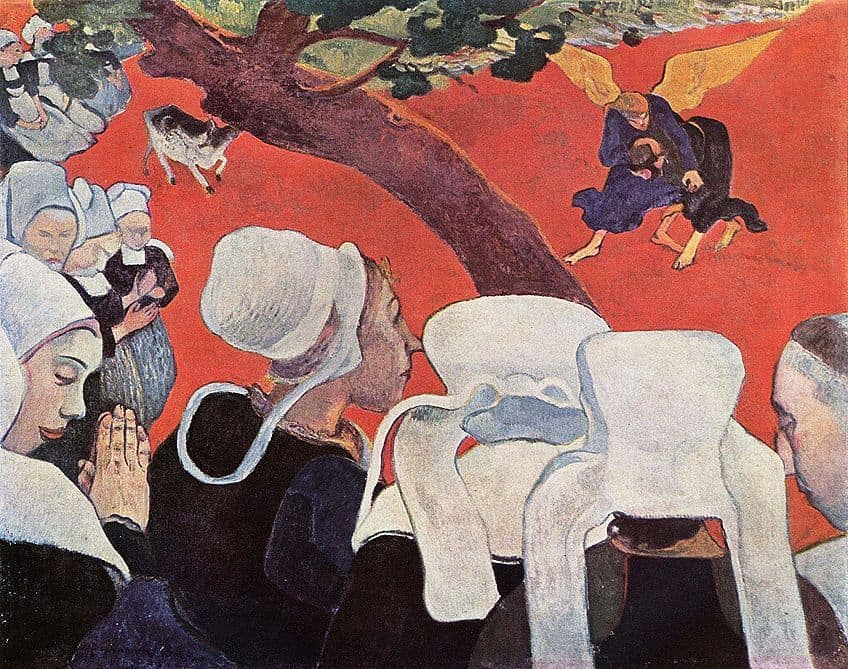
Material
One of the primary modes of how art specialists characterized primitive art was through the presence of other mediums that were not regarded as “sophisticated” or traditional mediums. These mediums and materials were also not widely adopted and included art objects made out of wood, ivory, bone, and sometimes metal.
Although these materials were also used in Western European art, they were not viewed as part of the “finer arts” at the time.
Color and Environment
Color or the production of various color pigments was also a factor of assessment when it came to viewing art through a stereotypical gaze. Primitive art was regarded as such if its color pigment properties differed from the classic oil-on-canvas approach. Color pigments that were produced naturally via minerals, vegetables, and animals were considered remnants of the past and not viewed through a formal visual arts perspective. The environment in which works of art have been presented throughout history is also traditionally seen as the white cube space that proposes that art is “aesthetically pleasing” and “valid” only if it is in a “proper gallery or white-walled setting”. Any art discovered outside of that context was immediately dismissed as art at all and rather seen as objects of inspiration.

Recognizable Imagery
Artwork previously considered primitive also includes artists from prehistory and artwork from the Paleolithic period. Artwork under these categories was interpreted as “simply designed” and contained imagery that was incredibly recognizable and was thus perceived as too simple to qualify as fine art. This conjured up the debate that art had to have conceptual and academic support for it to be accepted as art. Art from pre-colonial Africa is an excellent example of how many chose to label art forms from indigenous cultures such as the South African bushmen as “tribal”, “primitive”, or a sugar-coated description called “naturalistic”.
Thankfully with time, the viewpoint on naturalistic styles in art has shifted and one can subjectively recognize the beauty in mark-making itself as a sophisticated mode of expression.
Famous Examples of Primitive Art
Now that we have covered some of the key aspects of Primitivism and the different ways in which art has been historically defined, redefined, altered, and influenced, we can now introduce you to some famous examples of artwork and artists who explored Primitivism.
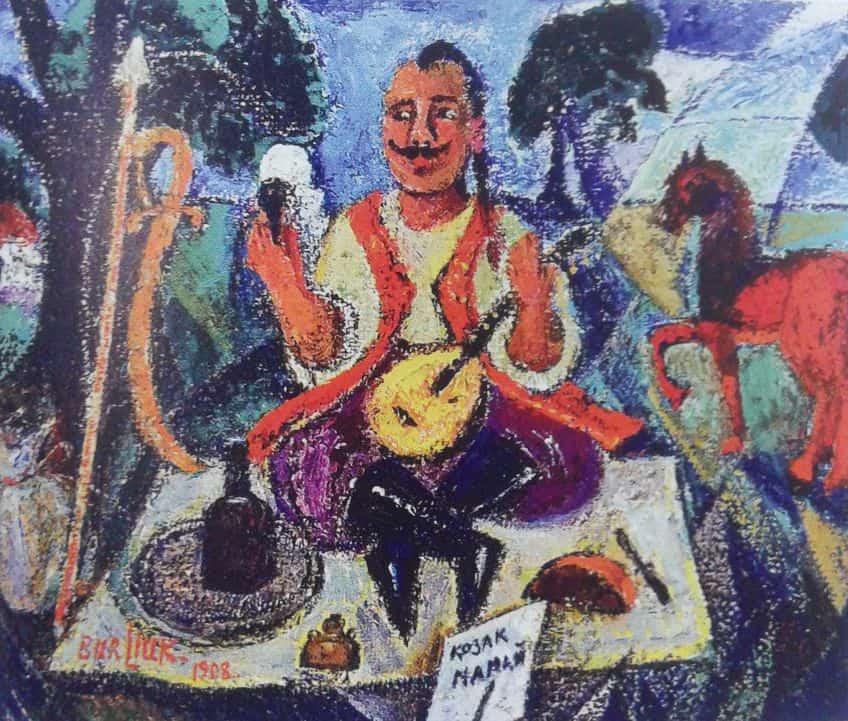
Spirit of the Dead Watching (1892) by Paul Gauguin
| Artist Name | Eugène Henri Paul Gauguin (1848 – 1903) |
| Date | 1892 |
| Medium | Oil on burlap mounted on canvas |
| Dimensions (cm) | 116.05 x 134.62 |
| Where It Is Housed | The Buffalo AKG Art Museum, Buffalo, New York, United States |
Paul Gauguin is one of the most famous names associated with the Primitivist art style. Gauguin was a largely unrecognized figure during his lifetime who was later understood as a post-Impressionist painter. His art style and approach were Symbolist and definitely not Impressionist, as many first assumed him to be. Gauguin embarked on a trip to one of the French colonies, Tahiti, in 1891, which would become a four-year-long stay that resulted in some of the artist’s most famous paintings. His Tahitian-inspired artwork was one of the most productive periods in his career.
According to Gauguin’s writings, he describes his productiveness as “with only a few months lost…I produced 66 fine canvases and a number of ultra-primitive sculptures.
That is enough for any one man”. Gauguin’s words alone demonstrate the intention for his visit. Some might argue that he was simply embarking on a journey to seek inspiration for his art, as many artists still do today. Yet, the context of the period and the fact that Gauguin labeled his art as “ultra-primitive”, indicates his then-obsessed state of benefitting off Polynesian cultures.
Spirit of the Dead Watching is one painting out of many that shows one a glimpse into the life and effect that Gauguin had on the Tahitian people. The main subject was a 13-year-old girl named Teha’amana, whom Gauguin referred to as “Tehura” in his writings. The most disturbing part of the account is that this young girl was Gauguin’s first sexual partner on the island since she was taken up as his “wife” or one of many as one might frame it. The painting shows the young child lying down on a bed with her eyes expressing a degree of concern. According to Gauguin’s description of her disposition, she was “frightened” and he suspected that she might have mistaken him for “one of the Tupapaus” or demons, as spoken about by the indigenous people.
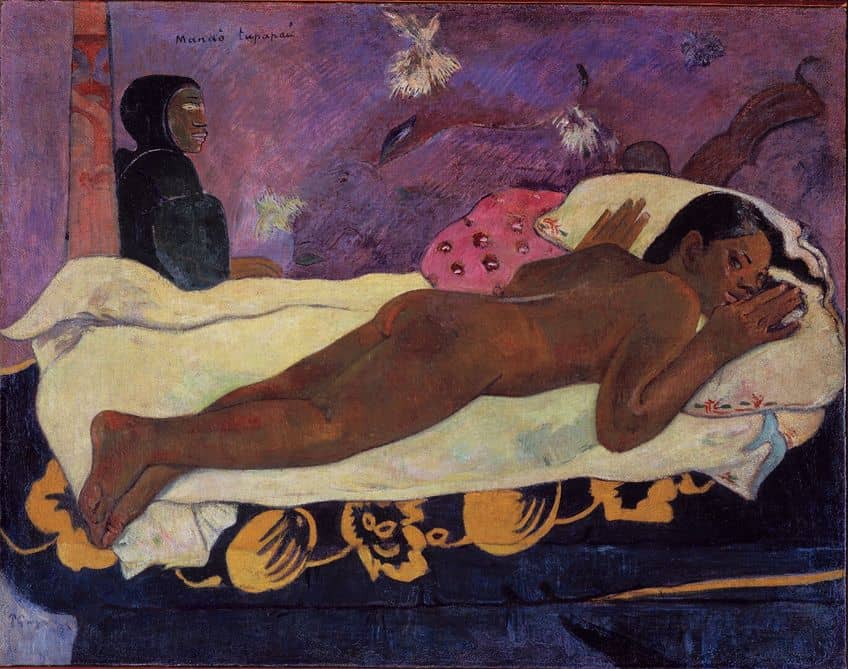
At the time, Gauguin was already engaged in sexual relations with many women on the island and he not only contracted an advanced sexually transmitted disease, but he also spread it to the young girl. It is disarming to imagine that the artist was fully aware of his actions yet chose to paint the subject that he himself played a part in creating. His escape from the rigidity of Christian life in Europe for sexual freedom yet a completely unhinged lack of self-control that was perceived to exist in the “elusive ideal” of Tahiti is something that cannot be overlooked above “primitive aesthetics”. In response to his work, Gauguin argued that his work was rather a celebration of society but one must ask the question “at what cost?”. This highlights the elusive void of inhumanity and ethics that exists when it comes to making “artistic decisions”. The concept of acting on artistic inclinations without ethical questioning or regard for realistic consequences is something of the past that sometimes seeps its way into the present. Spirit of the Dead Watching is thus a haunting painting with an equally haunting background.
Les Demoiselles d’Avignon (1907) by Pablo Picasso
| Artist Name | Pablo Picasso |
| Date | 1907 |
| Medium | Oil on canvas |
| Dimensions (cm) | 243.9 x 233.7 |
| Where It Is Housed | Museum of Modern Art, New York City, United States |
Les Demoiselles d’Avignon is another famous primitive painting that was created by popular Spanish artist Pablo Picasso in the early 20th century. Pablo Picasso is renowned for his contribution to Cubism, Surrealism, and Symbolism with his most famous work being Guernica (1937), which was inspired by the Spanish civil war. Les Demoiselles d’Avignon is a famous artwork commonly identified as Primitivist for its perceived lack of “realistic representation” of the female nude. The painting was initially titled The Brothel of Avignon and exposes Picasso’s use of the subject to explore his interest in Primitivism.
Picasso has for decades been admired for his ability to persevere in the competitive art world as an artist who suffers from dyslexia and who struggled in his formative years to create artwork that would be accepted as “successful” through the Western gaze. In creating the painting, Picasso stated that the sense of Primitivism in Les Demoiselles d’Avignon inspired him to “liberate an original artistic style of compelling… and savage force”.
When reviewing this statement, one might question the validity of an art style that is perceived as unique when similar mark-making and visual choices in painting have been executed before, just not in the same context that would have been perceived as “good art” by a Western audience.
The art style of Primitivism drew Picasso in as he observed the works of Paul Gauguin. According to an art history specialist, Picasso was heavily influenced by Gauguin’s work, which also touched on subjects that would have appealed to a select group of artists. Gauguin did not only explore the visual characteristics of Primitivism, but he also took an interest in classical mythology, metaphysics, Symbolism, and religious narratives from the Bible.
While Gauguin promoted Primitivism under the mask of freedom and shared a narrow vision of the “elusive ideal” from the repressed European male perspective, Picasso observed his “inspired revolutionary action” and was drawn to a similar foundation for the way that he could express the alternative representation of women in art such that he could also offer the West (on a pedestal) a “new art style” while benefiting from the visual “aesthetics” of African Fang mask designs. At one point, Picasso allegedly denied being influenced by the design of the masks, stating “African art? Never heard of it!” (L’art nègre? Connais pas!)”.
Around the early 20th century, and following the successes of Paul Gauguin, many artists began to look to Gauguin’s posthumous shows for inspiration, which led to the development of what we understand today to be Modern art. On the other end of the spectrum, one cannot ignore the way that visual traditions have not only shaped the way that Modern art and major movements like Cubism have allowed for alternative thinking around visual representation in the broader visual arts.
The Russian Neo-Primitivism Movement
Once Primitivism gained traction in Europe, the Russian art style known as Neo-Primitivism began to take shape. Neo-Primitivism had its origins in Russia and was specifically tied to the unpacking of Russian identity via artwork influenced by folk art and artifacts from prehistory that fell under the Russian Empire. The influence of Primitivism to say the least was one of the greatest since it helped spawn Neo-Primitivism, which spiked in popularity between 1908 and 1913.
Russian creatives were aware of the comparisons that would be made with their European counterparts and purposefully distinguished their works by including strictly Russian historical iconographies.
Some of the intriguing subjects and themes of Russian Neo-Primitivism was the incorporation of pre-historic Russian narratives, including myths of an indigenous culture known as Scythians. A few influential artists from this era include figures like Natalya Goncharova and Kazimir Malevich, who pioneered the Russian Neo-Primitivist Avant-Garde scene.

The Institutionalization of Primitive Art: Arts, Culture, and Politics
In 1957, an official museum was established that institutionalized “primitive art”. This museum was called the Museum of Primitive Art and was founded by the former Vice President of the United States, Nelson Rockefeller, prior to his former position in 1974. The museum’s collection promoted the exhibition of art from various continents such as Africa, Europe, Oceania, and Asia, all of which were continents that experienced the hand of colonial conquest.
Rockefeller donated artwork from his private collection, labeled as “tribal art” and the institution opened its doors on 15 West 54th Street, New York City. The museum’s director was Robert Goldwater. The institution closed in 1976, two years after Rockefeller’s instatement, and the collection was transferred to the Metropolitan Museum of Art under the Michael C. Rockefeller Wing. The Metropolitan Museum of Art currently houses various publications from the former museum in the Watson Library Digital Collections.
Many of the publications on topics related to African art, ancient Mayan sculpture, ancient Mexican art, Sudanese sculpture, and ancient Peruvian art among many others.
In 2013, a press release was published by the Metropolitan Museum of Art that announced an exhibition in celebration of the Rockefeller collection called The Nelson A. Rockefeller Vision: In Pursuit of the Best in the Arts of Africa, Oceania, and the Americas, which was supported by the “Friends of the Department of the Arts of Africa, Oceania, and the Americas”. According to, author and social anthropology expert, Nancy Lutkehaus, the decision for the MET to add the Michael C. Rockefeller Wing to the museum was a controversial one, given the complex politics of what it meant for an institution such as the MET to re-introduce previously perceived “primitive art” as fine art.
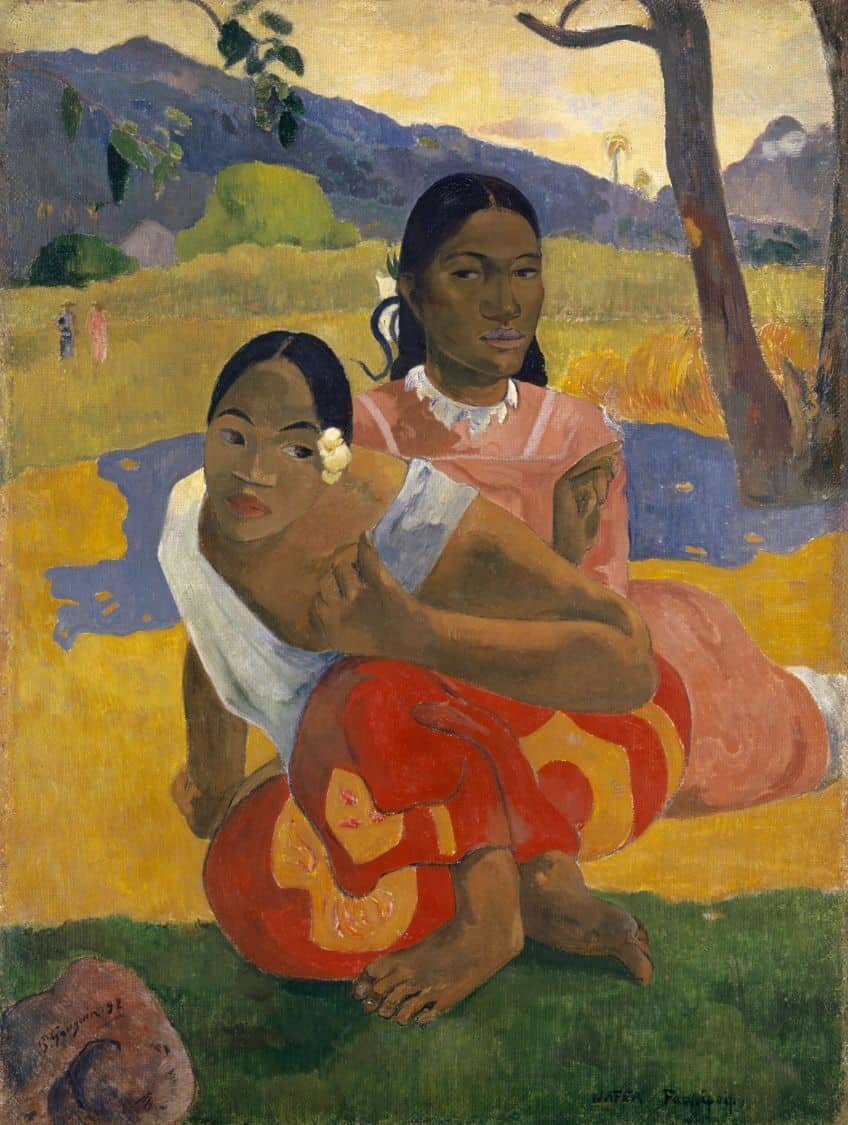
Lutkehaus also mentioned the interest that Nelson Rockefeller had in the role that art could play in the world of cultural politics. She further stated that when he became the president of the Museum of Modern Art (MoMA), an institution that was a major asset of wealth for David Rockefeller (1915-2017), Nelson Rockefeller essentially “created an inter-American council to recruit Latin-American artists to the United States in exchange for sending American art to Latin America. This was done over a concern during the Second World War that Fascism would dominate Latin America and so he leveraged the art collection and the MoMA to counteract the Fascist interests of Southern America.
The dynamic conversations that occur between the spheres of politics, culture, and the arts have proposed questions about the repatriation of artwork once considered “primitive”, including the conditions under which these artworks were attained, even if under the ownership of private collections. The relationships become even more intricate when artwork from indigenous cultures, retrieved under the guise of colonial conquest and the “elusive ideal”, is reframed as tools and spoken about in reference to warfare terminology while attempting to address the cultural disparity and centuries of Western-European dissociation from the art of indigenous groups. One has to re-examine the role of prominent museums as both active participants of history and proponents of cultural change, exchange, and political stability.
Take a look at our Primitivism art webstory here!
Frequently Asked Questions
What Is Primitivism?
In an art context, the Primitivism definition is informed by art that differs from the Western-European idea of conventional art and is a genre of art that mimics the visual elements and characteristics of art created by individuals who do not live in societies that are deemed to be so-called civilized by the greater West. A further breakdown of Primitivism definitions includes the historical view that a simpler life was superior to the lifestyle of technologically advanced societies. The Primitivist movement was founded by a French artist called Jean Dubuffet.
What Are Other Terms for Primitive Artwork?
Other terms used to refer to primitive artwork in a stereotypical and often generalized sense include sub-genres such as tribal art, cave art, and other artistic productions by societies that early anthropologists thought of as cultures without evidence of written languages or technological developments.
Which Artist Is Most Famous for Creating Primitive Paintings?
Pablo Picasso is regarded as the most famous creator of primitive paintings and artwork as defined by the Primitivist art style, which supported the development of Cubism.
Which Artists Are Associated with the Primitivism Movement?
Artists such as Pablo Picasso, Paul Gauguin, Marc Chagall, George Bellows, and Jack Levine, among many others, were part of the Primitivism movement.
Jordan Anthony is a Cape Town-based film photographer, curator, and arts writer. She holds a Bachelor of Art in Fine Arts from the University of the Witwatersrand, Johannesburg, where she explored themes like healing, identity, dreams, and intuitive creation in her Contemporary art practice. Jordan has collaborated with various local art institutions, including the KZNSA Gallery in Durban, the Turbine Art Fair, and the Wits Art Museum. Her photography focuses on abstract color manipulations, portraiture, candid shots, and urban landscapes. She’s intrigued by philosophy, memory, and esotericism, drawing inspiration from Surrealism, Fluxus, and ancient civilizations, as well as childhood influences and found objects. Jordan is working for artfilemagazine since 2022 and writes blog posts about art history and photography.
Learn more about Jordan Anthony and about us.
Cite this Article
Jordan, Anthony, “Primitive Art – Westernized Presentations of the “Other”.” artfilemagazine – Your Online Art Source. October 10, 2023. URL: https://artfilemagazine.com/primitive-art/
Anthony, J. (2023, 10 October). Primitive Art – Westernized Presentations of the “Other”. artfilemagazine – Your Online Art Source. https://artfilemagazine.com/primitive-art/
Anthony, Jordan. “Primitive Art – Westernized Presentations of the “Other”.” artfilemagazine – Your Online Art Source, October 10, 2023. https://artfilemagazine.com/primitive-art/.



